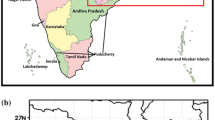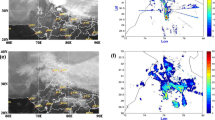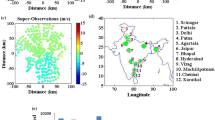Abstract
For the accurate and effective forecasting of a cyclone, it is critical to have accurate initial structure of the cyclone in numerical models. In this study, Kolkata Doppler weather radar (DWR) data were assimilated for the numerical simulation of a land-falling Tropical Cyclone Aila (2009) in the Bay of Bengal. To study the impact of radar data on very short-range forecasting of a cyclone's path, intensity and precipitation, both reflectivity and radial velocity were assimilated into the weather research and forecasting (WRF) model through the ARPS data assimilation system (ADAS) and cloud analysis procedure. Numerical experiment results indicated that radar data assimilation significantly improved the simulated structure of Cyclone Aila. Strong influences on hydrometeor structures of the initial vortex and precipitation pattern were observed when radar reflectivity data was assimilated, but a relatively small impact was observed on the wind fields at all height levels. The assimilation of radar wind data significantly improved the prediction of divergence/convergence conditions over the cyclone's inner-core area, as well as its wind field in the low-to-middle troposphere (600–900 hPa), but relatively less impact was observed on analyzed moisture field. Maximum surface wind speed produced from DWR–Vr and DWR–ZVr data assimilation experiments were very close to real-time values. The impact of radar data, after final analysis, on minimum sea level pressure was relatively less because the ADAS system does not adjust for pressure due to the lack of pressure observations, and from not using a 3DVAR balance condition that includes pressure. The greatest impact of radar data on forecasting was realized when both reflectivity and wind data (DWR–ZVr and DWR–ZVr00 experiment) were assimilated. It is concluded that after final analysis, the center of the cyclone was relocated very close to the observed position, and simulated cyclone maintained its intensity for a longer duration. Using this analysis, different stages of the cyclone are better captured, and cyclone structure, intensification, direction of movement, speed and location are significantly improved when both radar reflectivity and wind data are assimilated. As compared to other experiments, the maximum reduction in track error was noticed in the DWR–ZVr and DWR–ZVr00 experiments, and the predicted track in these experiments was very close to the observed track. In the DWR–ZVr and DWR–ZVr00 experiments, rainfall pattern and amount of rainfall forecasts were remarkably improved and were similar to the observation over West Bengal, Orissa and Jharkhand; however, the rainfall over Meghalaya and Bangladesh was missed in all the experiments. The influence of radar data reduces beyond a 12-h forecast, due to the dominance of the flow from large-scale, global forecast system models. This study also demonstrates successful coupling of the data assimilation package ADAS with the WRF model for Indian DWR data.






















Similar content being viewed by others
References
Albers S.C., McGinley, Birkenhuer D.A., Smart J.R. (1996), The local analysis and Prediction System (LAPS): Analysis of clouds, precipitation and temperature, Wea. and Fore. 11, 273-287.
Bratseth, A.M. (1986), Statistical interpolation by means of successive corrections, Tellus 38A, 439-447.
Brewster, K. (1996), Application of a Bratseth analysis scheme including Doppler radar data, Preprints 16 th Conf. on Weather Analysis and Forecasting. Amer. Meteor. Soc. 92–95.
Brewster, K. (2003), Recent advances in the diabetic initialization of a non-hydrostatic numerical model, Preprints 21st Conf. On Severe Local Storms and Preprints 15th Conf Num Wea Pred and 19th Conf, Wea. Ana Fore. Amer. Meteor. Soc. 51–54.
Brewster, K., Shapiro. A., Gao, J., Kemp, E.M., Robinson, P., Thomas, K.W. (2003), Assimilation of radar data for the detection of aviation weather hazards, Preprints 31st Conf on Radar Meteorology, Amer. Meteor. Soc. Boston 118–121.
Dong, J., et al. (2010), Ensemble Kalman filter assimilation of coastal WSR-88D radar data and forecasting for Hurricane Ike (2008), Presented at 29th Conference on Hurricanes and Tropical Meteorology, Amer. Meteor. Soc.
Dudhia, J., (1989), Numerical study of convection observed during the winter monsoon experiment using a mesoscale two-dimensional model, J. Atmos. Sci. 46, 3077–3107.
Harasti, P.R., McAdie, C.J., Dodge, P.P., Lee, W.C., Tuttle, J., Murillo, S.T., Marks, Jr. F.D. (2004), Real-time implementation of single Doppler radar analysis methods for tropical cyclones, Algorithm improvements and use with WSR-88D display data, Wea. Fore. 19, 219–239.
Hu, M., et al. (2005a), 3DVAR and Cloud Analysis with WSR-88D Level-II Data for the Prediction of Fort Worth Tornadic Thunderstorms Part I: Cloud analysis, Mon. Wea. Rev. 134(2), 675–698.
Hu, M., et al. (2005b) 3DVAR and Cloud Analysis with WSR-88D Level-II Data for the Prediction of Fort Worth Tornadic Thunderstorms Part II: Impact of radial velocity analysis via 3DVAR, Mon. Wea. Rev. 134(2), 699–721.
Hong, S.Y., Juang, H.M.H., Zhao, Q. (1998), Implementation of prognostic cloud scheme for a regional spectral model, Mon. Wea. Rev. 132, 2621–2639.
Hong, S.Y., Dudhia, J., Chen, S.H. (2004), A revised approach to ice microphysical processes for the bulk parameterization of clouds and precipitation, Mon. Wea. Rev. 132, 103–120.
Krishnamurti, T.N., Xue, J., Bedi, H.S., Ingles, K., Oosterhof, D. (1991), Physical initialization for numerical weather prediction over tropics, Tellus, 43A-B, 53–81.
Lakshmanan, V., Smith, T., Stumpf, G., Hondl, K.D. (2007a), The warning decision support system integrated information, Weather Forecast, 22, 596–612.
Lakshmanan V, Fritz A, Smith T, Hondl K, Stumpf G (2007b) An automated technique to quality control radar reflectivity data. J Appl Meteorol Climatol 46(3):288–305.
Lin, H. H., Lin, P. L., Xiao, Q. N., Kuo Y. H. (2011), Effect of Doppler radial velocity data assimilation on the simulation of a typhoon approaching Taiwan: A case study of Typhoon Aere (2004), Terr. Atmos. Oceanic. Sci. 22(3), 325–345, doi:10.3319/TAO.2010.10.08.01(A).
Prasad, K., Rama Rao, Y. V. (2003), Cyclone track prediction by a quasi-Lagrangian limited area model, Met. Atmos. Phys. 83, 173–185.
RSMC Tropical Cyclones Report on cyclonic disturbances over North Indian Ocean during-2009. India Meteorological Department (2009), New Delhi, India.
Rajeevan, M., et al. (2010), Sensitivity of WRF cloud microphysics to simulations of a severe thunderstorm event over Southeast India, Ann. Geophys. 28, 603–619.
Roy Bhowmik, S.K., Sen Roy, S., Srivastava, K, et al. (2011), Processing of Indian Doppler Weather Radar Data for mesoscale applications, Meteorl. Atmos. Phy. 111, 133–147.
Sen Roy, S., Lakshmanan,V., Roy Bhowmik, S.K., Thampi, S.B. (2010), Doppler Weather Radar based nowcasting of Cyclone Ogni, J. Ear. Sys. Sci. 119, 183–199.
Shamrock, W. C., Klemp, J.B., Dudhia, J., Gill, D.O., Barker, D.M., Wang, W., Powers, J. G. (2005), A description of the advanced research WRF version 2 NCAR Tech Note NCAR, TN-4681STR 88 pp.
Sikka, D.R. (1971), Evaluation of use of satellite photography in determining the location and intensity changes of tropical cyclones in Arabian sea and Bay of Bengal, Ind. J. meteorol. Hydrol. Geophys. 22, 305–312.
Sun, J. (2005), Initialization and numerical forecasting of a supercell storm observed during STEPS, Mon. Wea. Rev. 133, 793–81.
Xiao, Q., Kuo, Y.H., Sun, J., Lee, W.C., Barker, D.M., Lim, E. (2007), An approach of radar reflectivity data assimilation and its assessment with the inland QPE of Typhoon Rusa (2002) at landfall, J. Appl. Meteor. and Clim. 46, 14–22.
Zhang, J., Carr, F., Brewster, K. (1998), ADAS cloud analysis. Preprints 12th Conf on Num Wea Prediction, Phoenix, AZ, Amer. Meteor. Soc. Boston, 185–188.
Zhao. K., et al. (2012), Short-term forecasting through intermittent assimilation of data from Taiwan and mainland China coastal radars for Typhoon Meranti (2010) at landfall, Journal of Geophysical Research, 117, D06108 doi:10.1029/2011JD017109 2012.
Zhao, K., et al. (2009), Assimilation of coastal Doppler radar data with the ARPS 3DVAR and cloud analysis for the prediction of Hurricane Ike (2008), Geophysical Research Letters, 36, L12803, 6 pp 2009.
Zhaoxia, Pu., Xuanli, Li., Juanzhen, S. (2009), Impact of Airborne Doppler Radar Data Assimilation on the Numerical Simulation of Intensity Changes of Hurricane Dennis near a Landfall, Journal of the atmospheric sciences, 66, 3351–3365.
Acknowledgments
The authors are thankful to Guru Gobind Singh Indraprastha University, New Delhi, for support in carrying out this study. The authors are also grateful to the Director General of Meteorology, IMD, New Delhi, for encouragement in carrying out this work. The authors gratefully acknowledge the radar unit at H/Q, DWR Kolkata, NWP Division (IMD, New Delhi), NCEP (USA), NWP system (ARPS) of CAPS, University of Oklahoma (USA), the WRF model of NCAR (USA), and the HPCS system, IMD (New Delhi) for assistance in this study.
Author information
Authors and Affiliations
Corresponding author
Rights and permissions
About this article
Cite this article
Srivastava, K., Bhardwaj, R. Assimilation of Doppler Weather Radar Data in WRF Model for Simulation of Tropical Cyclone Aila. Pure Appl. Geophys. 171, 2043–2072 (2014). https://doi.org/10.1007/s00024-013-0723-5
Received:
Revised:
Accepted:
Published:
Issue Date:
DOI: https://doi.org/10.1007/s00024-013-0723-5




